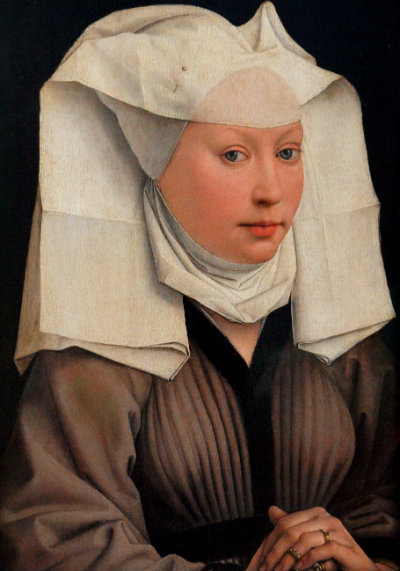Search:: Artists Alphabetically Artists by Country Artists by Century Artists by Movement
Rogier van der Weyden
1399-1464
One of the Greatest Painters Of All Time
Early Netherlandish Northern Renaissance Painter
Stylistically influenced by the following painters and art movements - Jan van Eyck and Robert Campin
Education - apprenticed to a local goldsmith and later to the workshop of Robert Campin.

Rogier van der Weyden Bio
Early Netherlandish painter Rogier van der Weyden lived during troubled and restless times. The world was in transition. The old feudal system imposed by the Church was buckling under the expansion of towns, the rise of the merchant class, the emergence of national states, the spread of religious reform and invention of the printing press. People were becoming fascinated with science, art and far off places. Rogier van der Weyden was born at the beginning of the modern world.
Rogier van der Weyden's early training was in the workshop of the town goldsmith. Although it is not known if he ever actually worked in the trade. Approaching thirty, he began assisting in the studio of Robert Campin, the greatest painter in Northern Europe at that time. Rogier absorbed the Gothic artistic tradition and influence, reinterpreting them in new innovative ways. After his assistantship with Campin he established his own studio in Brussels and quickly established himself as an international art superstar.
Within a few years Rogier was inundated with lucrative commissions from monarchs, the ruling church hierarchy and wealthy influential burghers. He worked with absolute concentration, demanding complete quiet in his workshop. Consistent with his former studies with Robert Campin, he defines his subject with a firm hand and exquisite draftsmanship.
Diffrences Between Northern Renaissance and Italian Renaissance Art
Many of the early paintings of the Northern Renaissance perished through time and the fierceness with which the Iconoclastic battles were waged. The Northern Renaissance was different from the Italian Renaissance in many ways. Painters of the North focused upon secular society rather than the Church and overblown religious themes. Northern Renaissance painters emphasis the daily life of the merchant and peasant class. They also put a greater emphasis on spirituality, piousness and living a simple life. Artists such as Dieric Bouts and Peter Brugal the Elder painted inspirational biblical scenes, the merchant class at work, idyllic scenes of peasants working at everyday tasks, playing games and feasting. Northern Renaissance painters seemed more in touch with the people. According to art historian John C. Van Dyke "As a whole their subjects were single figures or small groups in interiors, quiet scenes, family conferences, smokers, card-players, drinkers, landscapes, still-life, architectural pieces. ."The Italian Renaissance, on the other hand, focused more on the aristocracy and the theocracy. Painters highlighted the individual and glorified worldly pleasures, Paintings were sumptuous, elaborate, expressive, and exhalted wealthy and powerful people. Author Clive Bell observed "But whatever the Italian painters of the Renaissance had to say they said in the grand manner. Remember, we are not Dutchmen. Therefore let all your figures suggest the appropriate emotion by means of the appropriate gesture—the gesture consecrated by the great tradition. Straining limbs, looks of love, hate, envy, fear and horror, up-turned or downcast eyes, hands outstretched or clasped in despair."
The Italian Renaissance painters focused heavily on religion, Roman Catholicism. Popes and church hierarchy were wealthy, powerful rulers. Like kings they were depicted in elaborate settings swaddled in furs and silks.
Important Words, People, Phrases, Characteristics related to the Northern Renaissance Art Movement - allegorical painting, rebirth, invention of oil painting, Hieronymus Bosch, Limbourg Brothers, Desiderius Erasmus, Robert Campin, Jan Van Eyck, Jean Fouquet, Albrecht Dürer, Johannes Gutenberg, Johann Reuchlin, Martin Luther, rise of the merchant class, world landscape, Low Countries, Protestant Reformation, Calvinisim, glazing, impasto, scriptorium, illuminator, invention of the printing press, woodcuts, engravings, Antwerp School, Guild of Saint Luke, commerce, Flemish School, Northern Europe, Flanders, Bruges, renewed interest in classical learning, mythological scenes, genre painting, landscapes, portraits, moralizing overtones, human vices, lust, paradise, spirituality, piousness, living a simple life, reform, Human Reasoning, tradesmen at work, idyllic scenes of peasants, playing games, feasting, linear perspective, \Heliocentric Theory, humour, satire, spiritually significant, illuminated manuscript, idealized biblical themes, scriptorium, emotion, illuminator, iconoclast, Age of Discovery, Virgin and Child, axonometric drawing, curiosity about the natural world, realistic use of colours and light, Old Testament stories, Gospel parables, The Blackdeath, Christian symbolism
Require more facts and information about Rogier van der Weyden and Art history? Dig around every nook and cranny of the known universe for information this subject. Search Here
☼☼☼☼☼
© HistoryofPainters.com 2017